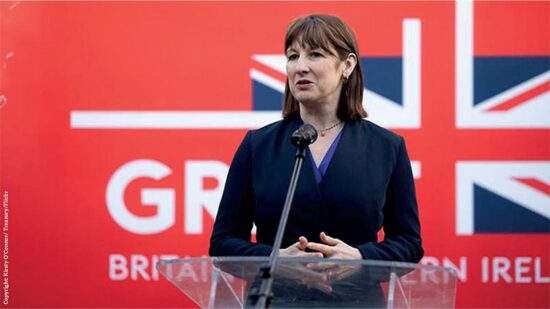The OBR’s latest forecasts for the UK economy – and the chancellor’s response to them in the Spring Statement – followed a pattern of not being quite as awful as expected, while not providing a great deal of hope. There was relief that the gilt market was unruffled, but were there any glimmers of hope for the UK equity market?
The UK stockmarket has performed well since the start of the year, with the FTSE All Share rising 4.6%. The domestically-focused small and mid-cap indices, however, have struggled. The FTSE 250 is down 4.8% year-to-date, and the FTSE Small Cap is down 3% over the same period.
The budget did little to boost confidence in the UK economy. The OBR halved its forecasts for economic growth in 2025. Although it raised forecasts for 2026 and beyond, the OBR made it clear that a lot could happen in the interim and relatively small moves in the gilt yield could unseat the UK’s growth projections once again.
There have been better economic signs emerging elsewhere. The latest PMI data suggests mounting strength in the services sector, while retail spending data shows that consumer confidence may be improving. The most recent CPI data was marginally lower than expected. None of this is reflected in improving growth figures yet, but that may happen over the coming months.
Where investors are gravitating to the UK, it appears to be for its defensive qualities at a tricky time, rather than because there is any real excitement about a turnaround in the UK economy.
See also: Five key takeaways from the Spring Statement
For example, Justin Onuekwusi, chief investment officer at St James’s Place, currently favours the UK stockmarket and the Spring Statement didn’t change his view. However, he likes it because the UK stockmarket is biased towards larger, value-oriented companies and industries, and tends to perform relatively well in volatile markets. “This, plus relatively cheap valuations, means UK equities look attractive,” he said.
Equally, the most obvious area of public spending priority – defence – will disproportionately benefit a handful of large-cap companies. There is the potential for smaller UK companies to benefit further down the line. The Treasury has said that £2.2bn in extra spending will be targeted at local manufacturing with the aim of making the UK a ‘defence superpower’.
St James’s Place said this is likely to be directed towards technologies such as drones and AI-enabled technology. However, it is difficult to predict the likely beneficiaries in the short term.
The other main beneficiary of government spending is the construction sector. While the housebuilders remained largely unmoved by the announcement of new housing targets, it should be a consistent boost for the sector.
Rebecca Maclean, co-manager of the Dunedin Income Growth Investment Trust, said: “Although the target for new homes has been adjusted to 1.3 million over the next five years, down from the original 1.5 million, progress is being made with the Planning and Infrastructure Bill. This legislation is crucial for unlocking infrastructure projects and implementing planning reforms, which should benefit the UK housebuilding sector.”
The chancellor announced other measures to boost the construction supply chain and to tackle labour shortages. This included the establishment of new technical colleges to boost skills. Maclean thinks this should help the housebuilding sector recovery and ensure it delivers on the housing targets.
The real estate sector gave the budget a comprehensive thumbs-up, with Paul Richards, chief executive officer at the Association of Real Estate Funds, saying: “Real estate and economic growth are symbiotic. They rise and recede together – and today we saw once more a blueprint for both to rise. And so, it was no surprise to see housing and infrastructure remain as centrepieces of the Government’s growth strategy.
“Our members will be particularly pleased to see more detail about the much-trailed planning reforms. We’ve talked about this for years: poor and inefficient planning impedes real estate and economic growth, good and efficient planning bolsters both. The boost to skills in the building industry is especially welcome.”
See also: ‘Road ahead is anything but smooth’ as UK inflation dips
For other sectors, there was little to cheer in the chancellor’s statement, though little cause for gloom either. Rachel Reeves did not reverse the Employer’s National Insurance rise announced in October, but nor did she raise taxes elsewhere, as had been feared.
Maclean believes this consistency will be welcome: “Greater political clarity could help restore confidence and stimulate economic activity.”
Bill Casey, equity portfolio manager at Schroders, said the trajectory for UK companies is determined by interest rates and growth.
“Lower rates are needed to reignite the investment cycle,” said Casey. “Lower rates are also key to improving fiscal headroom, which has eroded since October. Options are now limited and having seen the impact that shrinking the state in the US is having on the cost of US debt, the UK is taking a leaf out of the DOGE. Lowering the cost of UK debt compared to countries like Germany will be key in enabling animal spirits both in the real economy and the stockmarket.”
The UK economic recovery will not be built in a day, and it was always unlikely the budget would move UK markets significantly. If the early signs on business confidence, retail spending and inflation continue, it is possible that investors will start to look at the UK’s domestic businesses in the small and mid-cap sectors. In the meantime, its strength is as a defensive option at a time of uncertainty.








